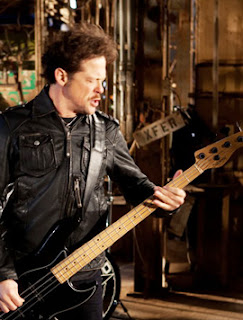At the heart of it is Dan McGee (vocals, guitar) and (for three albums) Gregg Levy (bass), who had played together on and off for the better part of 15 years. The rest of it was largely made up of whatever friends wanted to show up at studio sessions and live shows, until Rock Forbes signed on as a steady drummer.
The year ahead will mark another lineup shuffle as the band tours with Odessa labelmate Gross Ghost. Levy left shortly after the release of Shake My Head, leaving the bass open for multi-instrumentalist Steve Oliva, one of several guests who joined in for the last album.
There's something deliciously sticky about Shake My Head.
As one of the most overlooked albums released earlier this year, there aren't many better albums to play loud tonight. There is a recklessness to the 10-track lineup with grimy guitar work and always honest and sometimes medicated lyrics.
Queztacotl Love Song is a fine example. The lorazepam-induced song plays out like a middle-aged hippie trading in tie-dyed psychedelia for white collar comfort, while retaining tree hugger tendencies — peace, drugs, and nature traded up for peace, prescription meds, and environmentalism. Somehow it all goes together, especially with that crazy restrained rock calm.
Not everything they play is so medicated. Think of it as the exception. Keys To The City is a high strung gang song fantasy that begs for someone to kick up the debauchery. Permission to party, granted. The same spiraling frenzy is found on Friday Night, with its hard luck fall-out-of-love barstool confessional. (The track is still listed as a free download if you need another sample.)
Much of the album is like that. There isn't a whole lot of seriousness across the release, given it's a cross of drunken goodness and the unfortunately sad side effects that go along with it, usually on the morning after. Daymare plays to it all as the best twangy, slowly drawn out rock lament put out this year. Save it for the after party as everybody's eyelids get heavy and the bottles are nearing empty. Or not.
Pairing up McGee's music, both uptempo and downbeat, is what gives Spider Bags its addictiveness as it wavers back and forth between rock and roll or garage rock. Other standouts on the album include the swooning Shape I Was In, smooth The Moon Is A School Girl, and 60s-infused Standing On A Curb. There are also some stellar instrumental moments throughout Shawn Cripps Boogie.
All in all, there isn't a dud on the album, although you might consider adjusting the track arrangement. Most of Shake My Head is McGee finding the sweet spot between dirty rock with occasional punk- and deep South leanings and a meticulously produced album. It's especially amazing that Spider Bags can lay down what sounds to be a spontaneous ruckus even if it is all carefully planned. While other bands sometimes attempt to capture the energy of their live performance, these guys really do.
Shake My Head By Spider Bags Shake It Out At 8.2 On The Liquid Hip Richter Scale.
There really isn't any better way to wrap up another year of music reviews than with a band like Spider Bags. They can both close the show and kick off another round, which is exactly what they will be doing in January as they tour around with Gross Ghost for five back-to-back shows, starting with Durham, N.C., on Jan. 15.
Shake My Head by Spider Bags can be downloaded off iTunes. You can also find Shake My Head on Amazon or order the CD from Barnes & Noble. They also put out the single Teenage Eyes with Eileen as a B-side earlier this year. The two extra tracks are worth a listen too, although neither quite measure up to the romp found throughout Shake My Head. For band updates, look for the label Odessa Records on Facebook.
![Liquid [Hip]](https://blogger.googleusercontent.com/img/b/R29vZ2xl/AVvXsEjAFBQPqS7J0-rrttNoRYSsuwIePPZf4Nq6sqDioK1zzVQXJIQXKzq_NVNI4n6h3inuRQFBKOcJeZeSufkdHHIOxbSWyBjTjTxgKEQGyPzdwvkEEeECh4bI5YEGk4RWGUINSd7vulPQsCA/s1600-r/liquidhip.jpg)




























